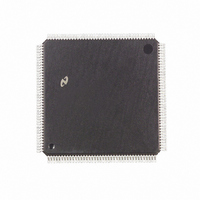DP83953VUL National Semiconductor, DP83953VUL Datasheet - Page 30

DP83953VUL
Manufacturer Part Number
DP83953VUL
Description
IC CTRLR RIC REPEATER 160-PQFP
Manufacturer
National Semiconductor
Datasheet
1.DP83953VUL.pdf
(90 pages)
Specifications of DP83953VUL
Controller Type
Ethernet Repeater Interface Controller
Interface
IEEE 802.3
Voltage - Supply
4.75 V ~ 5.25 V
Current - Supply
870mA
Operating Temperature
0°C ~ 70°C
Mounting Type
Surface Mount
Package / Case
160-MQFP, 160-PQFP
Lead Free Status / RoHS Status
Contains lead / RoHS non-compliant
Other names
*DP83953VUL
Available stocks
Company
Part Number
Manufacturer
Quantity
Price
Company:
Part Number:
DP83953VUL
Manufacturer:
HJC
Quantity:
2 010
Company:
Part Number:
DP83953VUL
Manufacturer:
Texas Instruments
Quantity:
10 000
4.0 Functional Description
4.7 Description Of Hardware Connection For Pro-
cessor And Display Interface
Display Update Cycles
The RIC2A possesses control logic and interface pins
which may be used to provide status information concern-
ing activity on the attached network segments and the cur-
rent status of repeater functions. These status cycles are
completely autonomous and require only simple support
circuitry to produce the data in a form suitable for a light
emitting diode "LED" display. The display may be used in
one of two modes:
1. Minimum mode - General Repeater Status LEDs
2. Maximum mode - Individual Port Status LEDs
Minimum mode, intended for simple LED displays, makes
available four status indicators. The first LED denotes
whether the RIC2A has been forced to activate its jabber
protect functions. The remaining 3 LEDs indicate if any of
the RIC2A's network segments are: (1) experiencing a col-
lision, (2) receiving data, (3) currently partitioned. When
minimum display mode is selected the only external com-
ponents required are a 74LS374 type latch, the LEDs and
their current limiting resistors.
Maximum mode differs from minimum mode by providing
display information specific to individual network segments.
This information denotes the collision activity, packet
reception and partition status of each segment. In the case
of 10BASE-T segments the link integrity status and polarity
of the received data are also made available. The wide
variety of information available in maximum mode may be
used in its entirety or in part. This allows the system
designer to choose the appropriate complexity of status
display commensurate with the specification of the end
equipment.
Signal Pin Name
D(7:5)
STR0
STR1
D0
D1
D2
D3
D4
No operation
Provides status information indicating if there is a collision occurring on one of the segments
attached to this RIC2A.
Provides status information indicating if one of this RIC2A's ports is receiving a data or collision
packet from a segment attached to this RIC2A.
Provides status information indicating that the RIC2A has experienced a jabber protect condi-
tion.
Provides Status information indicating if one of the RIC2A's segments is partitioned.
No operation
This signal is the latch enable for the 374 type latch.
This signal is held at a logic one.
Table 2. Status Display Pin Functions in Minimum Mode
(Continued)
Function in MINIMUM MODE
30
The signals provided and their timing relationships have
been designed to interface directly with 74LS259 type
addressable latches. The number of latches used being
depend upon the complexity of the display. Since the
latches are octal, a pair is needed to display each type of
segment specific data (13 ports means 13 latch bits). The
accompanying Table 2 and Table 3 show the function of the
interface pins in minimum and maximum modes. Table 4
shows the location of each port's status information when
maximum mode is selected. This may be compared with
the connection diagram Figure 12.
Immediately following the Mode Load Operation (when the
MLOAD pin transitions to a high logic state), the display
logic performs an LED test operation. This operation lasts
one second. While it is in effect, all of the utilized LEDs will
blink on. Thus, an installation engineer is able to test the
operation of the display by forcing the RIC2A into a reset
cycle (MLOAD forced low). The rising edge on the MLOAD
pin starts the LED test cycle. During the LED test cycle
the RIC2A does not perform packet repetition opera-
tions.
The status display possesses a capability to lengthen the
time an LED is active. At the end of the repetition of a
packet, the display is frozen showing the current activity.
This freezing lasts for 30 milliseconds or until a subsequent
packet is repeated. Thus at low levels of packet activity, the
display stretches activity information to make it discernible
to the human eye. At high traffic rates the relative bright-
ness of the LEDs indicates those segments with high or
low activity.
It should be mentioned that when the Real Time Interrupt
(RTI) occurs, the display update cycle will stop and after
RTI is serviced, the display update cycle will resume activ-
ity.
www.national.com











